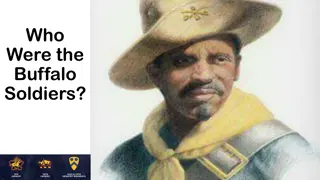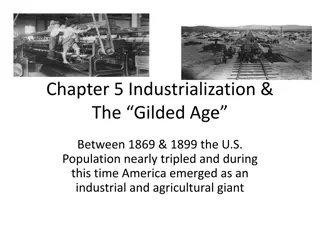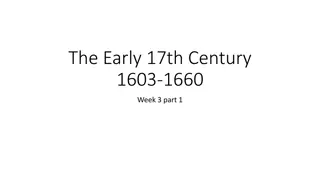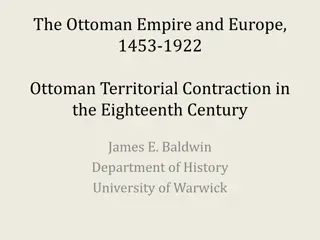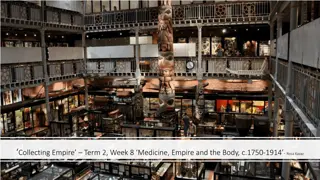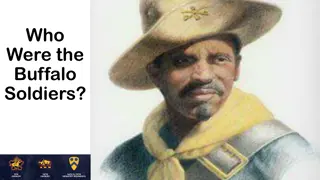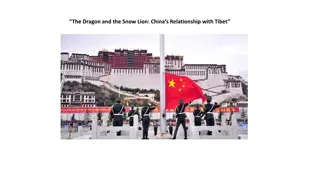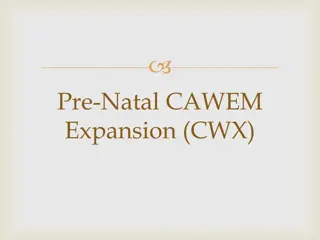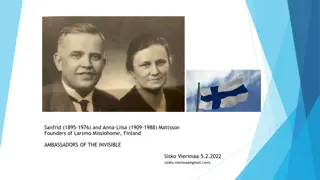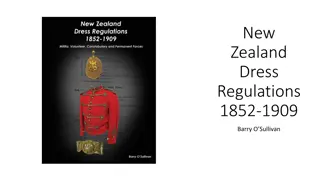The Era of Good Feelings and Westward Expansion in Early 19th Century America
The Era of Good Feelings (1817-1823) marked a period of national unity and political agreement in the United States, leading to a focus on expansion and development. This era saw significant diplomatic achievements and a surge in westward migration, particularly to areas like the Old Northwest and Old Southwest. As Americans moved westward, different frontiers emerged, with New Englanders emphasizing religion and opposition to slavery while the South saw the replication of plantation culture and the spread of slavery. The election of James Monroe in 1816 sealed the dominance of the Democratic-Republicans over the Federalists.
Download Presentation

Please find below an Image/Link to download the presentation.
The content on the website is provided AS IS for your information and personal use only. It may not be sold, licensed, or shared on other websites without obtaining consent from the author. Download presentation by click this link. If you encounter any issues during the download, it is possible that the publisher has removed the file from their server.
E N D
Presentation Transcript
The Era of Good Feelings (1817-1823)
One Nation With the War of 1812 behind them, Americans turned, more seriously than ever before, to the tasks of EXPANSION and DEVELOPMENT The so-called Era of Good Feelings found politicians were largely in agreement on a national agenda String of diplomatic achievements forged by John Quincy Adams gave the nation sharper definition.
America Growing Westward Westward Surge The end of the War of 1812 was followed by a westward surge The Old Northwest (Ohio, Indiana, Illinois, Michigan & Wisconsin) and The Old Southwest (Western Georgia, Alabama, Mississippi & Louisiana). Contributing factors Population surge between 1800 and 1820 (5.3 mil to 9.6 mil). Mainly 2.5 mil farmers went westward - Overpopulated farmland in seaboard states pushed farmers off the land - Defeat of and removal of Native population after War of 1812 - Land prices decreased (land Act of 1820)
Different Western Frontiers New Englanders expanded Westward and brought their religion, their love of learning, and their adamant opposition to slavery Western Migration in the South was very different Like on other frontiers, pioneers struggled on wagons through bush roads in the wilderness, encountered resistance from Native Americans and cleared the land for settlements and farms. HOWEVER On this frontier the hands on the ax were likely Black, and the people clearing the land were doing it not for themselves but to create plantations for the slave owners More than half of the migrants to the Old Southwest after 1812 were involuntary enslaved African Americans
Southwest Frontier and slavery Before the war, plantation owners in Mississippi made fortunes growing cotton, which they shipped to Britain from New Orleans After the war, cotton growing expanded and hopeful slave owners from older parts of the South (Virginia, N. and S. Carolina, Georgia) flooded into the region Most of the families of the Old Southwest were small farm families living in forest clearings Most farmers did not own slaves, but they hoped to, because ownership of slaves was a means to wealth Quickly the lifestyle and values of the older southern states were replicated on this new frontier
Election of 1816 In 1816 James Monroe was elected President over his Federalist opponent, Rufus King (183 to 34 electoral votes) This was the last election in which Federalists ran a candidate Monroe had no opponent in 1820 The triumph of the Democratic-Republicans over the Federalists seemed complete Although the Dem-Reps kept their name, they had accepted so many Federalists political principles it wasn t easy to tell which party triumphed
The Changing Political Landscape James Monroe (1817-1825) James Monroe was the last of the Virginia Dynasty Presidents His politics reflected changing times - Soon after his inauguration, he made a goodwill tour of the country, the first Pres. since Washington to do so - He went farthest west any Pres. had yet travelled to visit the frontier post of Detroit - In Boston (A Federalist stronghold) he received an enthusiastic welcome, prompting the Federalist newspaper Columbian Centinel to proclaim an Era of Good Feelings .
Changing landscape continued Monroe chose a government of national unity choosing men from both the North and the South (Dem-Republicans and Federalists) for his cabinet John Quincy Adams (a former Federalist) as his Secretary of State John C. Calhoun of South Carolina, a prominent War Hawk, as secretary of war. Supported the American System a program of national economic development that became identified with Westerner Henry Clay, Speaker of the House of Representatives
The American System Madison and Monroe broke with Jefferson s agrarianism to embrace much of the Federalist program for economic development The support Madison and Monroe gave Hamilton s ideas following the War of 1812 was a crucial sign of the dynamism of the American commercial economy Chartering of a national bank - A tax on imported goods to protect American manufacturing - A national system of roads and canals - All three of these had first been proposed by Alexander Hamilton in the 1790s and had been meet with bitter opposition by Dem-Repubs. The active support of these capitalists developments explained by so many Federalists were willing to join Monroe s party of national unity
Second Bank of the United States In 1816, Congress chartered the Second Bank of the United States for 20 yrs. To provide large-scale financing that smaller state banks could not handle To create a strong national currency Because they feared concentrated economic power, Democratic-Republicans allowed the charter of the first bank (1791) to expire in 1811 The 2ndBank was a sign that the strength of commercial interests had grown to rival that of farmers, whose distrust for central banks persisted
The Tariff of 1816 Was the first substantial protective tariff in American history. In 1815, British manufacturers, who had been excluded for 8 yrs (from Embargo Act of 1807 to end the war of 1812) flooded the United States market with their products American manufacturers complained that the British were dumping their goods below cost to prevent the growth of American industries Congress responded with a tariff on imported woolens and cottons, on iron, leather, hats, paper and sugar. The measure had southern as well as northern support, although in later years differences over the passage of higher tariffs would become one of the most persistent sources of sectional conflict
Internal Improvements Roads and Canals Madison and Monroe both supported national interstate projects such as the National Road from Cumberland, Maryland to Vandalia, Illinois. Congressmen, wanted to direct funds to their districts for improvements. They proposed spending federal money on local projects. Both Madison and Monroe vetoed the proposals. Some of most famous projects ie. Eerie Canal (entirely within the state of NY) and early railroads were financed by state or private money The support of Madison and Monroe for measures initially identified with their political opposition was an indicator
John Quincy Adams - Diplomacy Diplomatic achievements of the Era of Good Feelings due almost entirely to efforts of JQA Nationalism A feeling of pride, loyalty and protectiveness towards your country (Nationalism) affected US economic growth and foreign policy + Americans begin to feel torn between the interests of their own regions and those of the country as a whole (separatism) Nationalist spirit during Era of Good Feelings made US leaders want to define and expand borders so needed to reach agreements with Spain and Britain Britain vs. US - Convention of 1818 set US-Canadian border at 49thparallel as far west as the Rocky Mountains
JQA Diplomacy cont.. (Spain) US v. Spain disagreed on boundaries of Louisiana Purchase and W. Florida John Quincy Adam s major diplomatic accomplishment was the Adams-Onis or Transcontinental Treaty of 1819, in which he skillfully wrestled concessions from the faltering Spanish Empire Spain gave up Florida and the Oregon Country Why? 1816 Jackson led American forces on a mission to end Seminole raids along Florida border Jackson invades Florida and his success showed strength of US John Adams convinced Spain to give up Florida Highlighted Americas growing confidence in foreign affairs
Missouri Compromise 1819-1821 Sectionalism became a major issue when Missouri applied for statehood in 1817 Sectionalism Loyalty to the interests of your own region or section of the country, rather than the nation as a whole 1sttime the nation confronts the momentous issue that was buried in the general enthusiasm for expansion during the Era of Good Feelings As America moved west, would the largely southern system of slavery expand as well? Until 1819, this question was decided regionally 11 slave states and 11 free states Adding MO as a slave state would upset the balance of power
Sectionalism Proposal made by James Tallmadge of NY to ban slavery in MO. Southerners believed the Constitution didn t give Congress the right to ban slavery. Thomas Cobb (GA) If you persist, the Union will be dissolved. You have kindled a fire which all the waters of the ocean cannot put out, which seas of blood can only extinguish Maine (a part of Massachusetts) also wanted statehood Henry Clay The Missouri Compromise of 1820 Missouri be admitted as a slave state and Maine as a free state Slavery was banned from the Louisiana Territory north of the parallel 36 degrees 30 Latitude line, Missouri s southern border Thomas Jefferson on sectionalism In the gloomiest moment of the Revolutionary War, I never had any apprehension equal to what I feel from this source .
Latin America In 1821, Mexico achieves its independence from Spain 1822, Argentina, Chile and Columbia were independent as well Adams took notice of these changes in Latin America The US was the first country outside Latin America to recognize the independence of Spain s former colonies European powers began to talk of a plan to help Spain recover its lost colonies The British, suspicious of European powers, proposed a British- American declaration against European intervention in the hemisphere Showing the national pride so characteristic of the era, Adams insisted on an independent American policy
The Monroe Doctrine December 2, 1823, the president presented the Monroe Doctrine to congress and the world He called for the end of colonization of the Western Hemisphere by European nations Intervention by European powers in the affairs of the independent New World nations would be considered by the United States a danger to its own peace and safety Monroe pledged that the US would not interfere in the affairs of European countries or in the affairs of their remaining New World colonies. A committed nationalist and expansionist, he showed that reason and diplomacy were in some circumstances more effective than force
Conclusion The Monroe Doctrine showed that the United States saw itself as a world power and protector of Latin America Review of economies: South Cotton and slavery North Manufacturing and trade West Cheap land and good transportation



